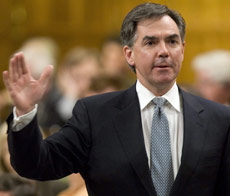Federal strategy appears to mask rules that will reshape Canadians’ rights over personal property
Michael Geist
Sun
In 2004, the Supreme Court of Canada issued a landmark copyright decision in a battle between the Law Society of Upper Canada, the Ontario legal bar association, and CCH Canadian, a leading legal publisher.
The court was faced with a dispute over an old technology — photocopying in a law library — and in a unanimous decision it ruled that the underlying purpose of copyright law is to serve the public interest. That interest, reasoned Chief Justice Beverley McLachlin, is best served by balancing both user rights and creator rights.
On Thursday, Industry Minister Jim Prentice and Canadian Heritage Minister Josee Verner delivered what amounts to a stinging rebuke to the Supreme Court’s copyright vision of public interest and balance. After months of internal discussions (though precious little public consultation), the government unveiled its much-anticipated copyright reform bill.
Casting aside the concerns of major business, education, and consumer groups, the bill seeks to dramatically tilt Canadian law toward greater enforcement and restrictions on the use of digital content, leading Liberal industry critic Scott Brison to warn that it could result in a “police state.”
Prentice’s strategy appears to have been to include a series of headline-grabbing provisions that would attract the support of the Canadian public and simultaneously mask rules that will reshape Canadians’ rights over their personal property.
Accordingly, the bill includes a time-shifting provision that legalizes recording of television programs, a private copying of music provision that allows consumers to copy music onto their iPods, and a format-shifting provision that permits transferring content from analog to digital formats.
While those provisions sound attractive, Canadians would do well to read the fine print. The new rules are subject to a host of limitations — Canadians can’t retain recorded programs and backing up DVDs is not permitted — that lessen their attractiveness. More worrisome are the “anti-circumvention provisions,” which undermine not only these new consumer rights but also hold the prospect of locking Canadians out of their own digital content.
The law creates a blanket prohibition on picking the digital locks (often referred to as circumventing technological protection measures) that frequently accompany consumer products such as CDs, DVDs, and electronic books. In other words, Canadians that seek that to circumvent those products — even if the Copyright Act permits their intended use — will now violate the law.
While this sounds technical, circumvention is not uncommon. Under the Prentice bill, transferring music from a copy-protected product to an iPod could violate the law. So too could efforts to play a region-coded DVD from a non-Canadian region or students’ attempts to copy-and-paste content from some electronic books.
The bill includes a few limited circumvention exceptions for privacy, encryption research, interoperable computer programs and security, yet the exceptions are largely illusory since the software programs needed to pick the digital lock in order to protect privacy or engage in research are banned.
Canadians should therefore check the fine print again — the law suggests that they can protect their privacy, but renders the distribution of the tools to do so illegal.
The need to read the fine print does not end there — a new statutory damage award of $500 for personal use infringement applies to music downloading that many believe is legal, while it does not cover uploading files onto peer-to-peer networks or even posting videos to YouTube. Similarly, a provision designed to allow librarians to create digital copies for patrons suffers from an exception that requires the digital copy to self-destruct within five days, effectively turning librarians into digital locksmiths.
Had Prentice and Verner respected the Supreme Court’s emphasis on balance and the public interest, they could have easily avoided this one-sided approach.
Canada’s earlier copyright bill, which died on the order paper in 2005, along with the approach in countries such as New Zealand, has identified a more balanced framework that preserves user rights by only prohibiting circumvention where the underlying purpose is to infringe copyright.
That approach ensures that the law targets commercial piracy rather than consumer property.
Instead, their self-described “made in Canada” solution actually looks an awful lot like the much-criticized U.S. Digital Millennium Copyright Act. Once Canadians read the fine print on this bill, many may demand that the government go back to the drawing board.
Michael Geist holds the Canada Research Chair in Internet and E-commerce Law at the University of Ottawa, Faculty of Law. He created the Fair Copyright for Canada Facebook group that has over 42,000 members and advocates for balanced copyright reform. He can be reached at [email protected] or online at www.michaelgeist.ca.






